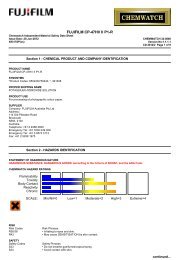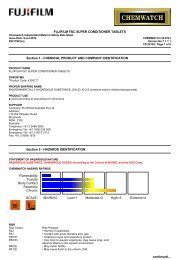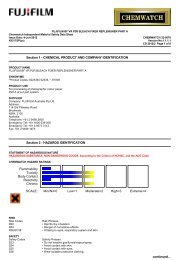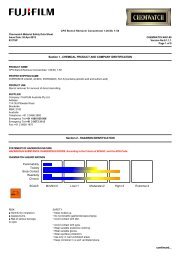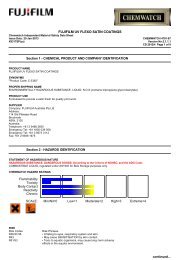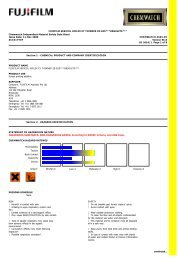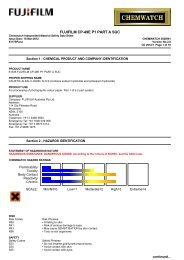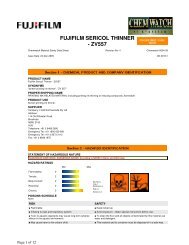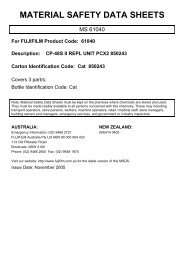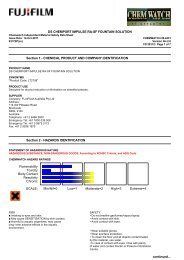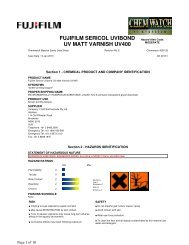CPS Haze Remover HV - FUJIFILM Australia
CPS Haze Remover HV - FUJIFILM Australia
CPS Haze Remover HV - FUJIFILM Australia
Create successful ePaper yourself
Turn your PDF publications into a flip-book with our unique Google optimized e-Paper software.
California Crop Improvement AssociationParsons Seed Certification Center, University of California, Davis, California 95616-8541Phone # (530) 752-0544 / FAX # (530) 752-4735APPLICATION FOR DISEASE INSPECTION PROGRAMAPPLICANT____________________________________________________________________ Date__________________Mailing Address _________________________________________________________________ Account # ______________CCIA Use_________________________________________________________________ Zip Code _____________Telephone Numbers (Include area codes):Office: ______________________ Cellular:______________________FAX:___________________Pager: _____________________GROWER______________________________________________________________________Crop ___________________________ Variety* ____________________________ Acres/Hectares Applied __________Parent Seed Stock #’s __________________________________________Disease Inspection Program # _____________CCIA UseIt is strongly suggested that all parent stock be field inspected and/or assayed for bacterial fruit blotch.FIELD INFORMATION -- Attach to the BACK two (2) copies of a detailed map for the field. Maps may be aerialphotos, farm maps, or a sketch, and should indicate road names, field boundaries, and distance and directions fromnearest town, intersection, or landmark. Maps must also show application number, field name or number, acreage,township, range, section; or latitude and longitude.County or Country _______________________________ Date Planted_________________________________________Field Reference/Identification Number (FPO/Cross/Material) _______________________________________________Submit Applications directly to the California Crop Improvement Association office.Applicant’s Name _______________________________Please printApplicant’s Signature _______________________________The applicant agrees to abide by the protocol of the CCIA Disease Inspected Program. Failure tocomply with these conditions may result in the inability of CCIA to complete field inspections and/orissue Disease Inspected Labels. The applicant agrees that they are ultimately responsible for seedquality.*Variety of seed is not determined by these inspectionsCopy Distribution: Applicant CCIA Inspector 9/00C:DIPAPP.FOR
<strong>CPS</strong> HAZE REMOVER <strong>HV</strong>Chemwatch Independent Material Safety Data SheetIssue Date: 25-Jul-2013 CHEMWATCH 4861-179317SP(cs)Version No:2.1.1.1CD 2013/2 Page 2 of 9Section 2 - HAZARDS IDENTIFICATIONS39S40S27S26S45S60• Wear eye/face protection.• To clean the floor and all objects contaminated by this material, use water.• Take off immediately all contaminated clothing.• In case of contact with eyes, rinse with plenty of water and contact Doctor orPoisons Information Centre.• In case of accident or if you feel unwell IMMEDIATELY contact Doctor orPoisons Information Centre (show label if possible).• This material and its container must be disposed of as hazardous waste.Section 3 - COMPOSITION / INFORMATION ON INGREDIENTSNAME CAS RN %sodium hypochlorite 7681-52-9 1-5sodium hydroxide 1310-73-2 1-5sodium carbonate 497-19-8 1-5cocamine oxide 61788-90-7
<strong>CPS</strong> HAZE REMOVER <strong>HV</strong>Chemwatch Independent Material Safety Data SheetIssue Date: 25-Jul-2013 CHEMWATCH 4861-179317SP(cs)Version No:2.1.1.1CD 2013/2 Page 3 of 9Section 4 - FIRST AID MEASURES• Emesis or lavage and catharsis may be indicated for mild caustic exposure.Excellent warning properties force rapid escape of personnel from chlorine vapour thus most inhalations are mild to moderate. Ifescape is not possible, exposure to high concentrations for a very short time can result in dyspnea, haemophysis and cyanosiswith later complications being tracheobroncho-pneumonitis and pulmonary oedema.Depending on the degree of exposure, periodic medical examination is indicated. The symptoms of lung oedema often do not manifestuntil a few hours have passed and they are aggravated by physical effort.Section 5 - FIRE FIGHTING MEASURESEXTINGUISHING MEDIA• Water spray or fog.• Foam.• Dry chemical powder.• BCF (where regulations permit).FIRE FIGHTING• Alert Fire Brigade and tell them location and nature of hazard.• Wear full body protective clothing with breathing apparatus.• Prevent, by any means available, spillage from entering drains or water course.• Use fire fighting procedures suitable for surrounding area.FIRE/EXPLOSION HAZARD• Non combustible.• Not considered to be a significant fire risk.• Expansion or decomposition on heating may lead to violent rupture of containers.• Decomposes on heating and may produce toxic fumes of carbon monoxide (CO).Decomposes on heating and produces toxic fumes of: hydrogen chloride.FIRE INCOMPATIBILITY■ None known.HAZCHEM2XSection 6 - ACCIDENTAL RELEASE MEASURESMINOR SPILLS• Drains for storage or use areas should have retention basins for pH adjustments and dilution of spills before discharge ordisposal of material.• Check regularly for spills and leaks.• Clean up all spills immediately.• Avoid breathing vapours and contact with skin and eyes.• Control personal contact with the substance, by using protective equipment.• Contain and absorb spill with sand, earth, inert material or vermiculite.MAJOR SPILLS• Clear area of personnel and move upwind.• Alert Fire Brigade and tell them location and nature of hazard.• Wear full body protective clothing with breathing apparatus.• Prevent, by any means available, spillage from entering drains or water course.Personal Protective Equipment advice is contained in Section 8 of the MSDS.Section 7 - HANDLING AND STORAGEPROCEDURE FOR HANDLING• DO NOT allow clothing wet with material to stay in contact with skin.• Avoid all personal contact, including inhalation.• Wear protective clothing when risk of exposure occurs.• Use in a well-ventilated area.• WARNING: To avoid violent reaction, ALWAYS add material to water and NEVER water to material.continued...
<strong>CPS</strong> HAZE REMOVER <strong>HV</strong>Chemwatch Independent Material Safety Data SheetIssue Date: 25-Jul-2013 CHEMWATCH 4861-179317SP(cs)Version No:2.1.1.1CD 2013/2 Page 4 of 9Section 7 - HANDLING AND STORAGESUITABLE CONTAINER■ Liquid inorganic hypochlorites shall not to be transported in unlined metal drums. Inner packagings shall be fitted with ventedclosures and plastics drums and carboys shall have vented closures or be performance tested to a minimum of 250 kPa.• Lined metal can, lined metal pail/ can.• Plastic pail.• Polyliner drum.• Packing as recommended by manufacturer.For low viscosity materials• Drums and jerricans must be of the non-removable head type.• Where a can is to be used as an inner package, the can must have a screwed enclosure.
<strong>CPS</strong> HAZE REMOVER <strong>HV</strong>Chemwatch Independent Material Safety Data SheetIssue Date: 25-Jul-2013 CHEMWATCH 4861-179317SP(cs)Version No:2.1.1.1CD 2013/2 Page 6 of 9Section 9 - PHYSICAL AND CHEMICAL PROPERTIESMelting Range (°C) Not Available Viscosity Not AvailableBoiling Range (°C) 100 Solubility in water (g/L) MiscibleFlash Point (°C) Not Applicable pH (1% solution) Not AvailableDecomposition Temp (°C) Not Available pH (as supplied) 11- 13Autoignition Temp (°C) Not Applicable Vapour Pressure (kPa) Not AvailableUpper Explosive Limit (%) Not Applicable Specific Gravity (water=1) 1.12Lower Explosive Limit (%) Not Applicable Relative Vapour Density Not Available(air=1)Volatile Component (%vol) Not Available Evaporation Rate Not AvailableSection 10 - STABILITY AND REACTIVITYCONDITIONS CONTRIBUTING TO INSTABILITY• Presence of incompatible materials.• Product is considered stable.• Hazardous polymerisation will not occur.For incompatible materials - refer to Section 7 - Handling and Storage.Section 11 - TOXICOLOGICAL INFORMATIONPOTENTIAL HEALTH EFFECTSACUTE HEALTH EFFECTSSWALLOWED■ The material can produce chemical burns within the oral cavity and gastrointestinal tract following ingestion.Accidental ingestion of the material may be damaging to the health of the individual.Ingestion of alkaline corrosives may produce burns around the mouth, ulcerations and swellings of the mucous membranes, profusesaliva production, with an inability to speak or swallow. Both the oesophagus and stomach may experience burning pain; vomitingand diarrhoea may follow. Epiglottal swelling may result in respiratory distress and asphyxia; shock can occur. Narrowing of theoesophagus, stomach or stomach valve may occur immediately or after a long delay (weeks to years). Severe exposure can perforatethe oesophagus or stomach leading to infections of the chest or abdominal cavity, with low chest pain, abdominal stiffness andfever. All of the above can cause death.Ingestion of hypochlorites may cause burning in the mouth and throat, abdominal cramps, nausea, vomiting, diarrhoea, pain andinflammation of the mouth and stomach, fall of blood pressure, shock, confusion,and delirium. Severe poisonings may leadconvulsion, coma and death.EYE■ The material can produce chemical burns to the eye following direct contact. Vapours or mists may be extremely irritating.If applied to the eyes, this material causes severe eye damage.Direct eye contact with corrosive bases can cause pain and burns. There may be swelling, epithelium destruction, clouding of thecornea and inflammation of the iris. Mild cases often resolve; severe cases can be prolonged with complications such aspersistent swelling, scarring, permanent cloudiness, bulging of the eye, cataracts, eyelids glued to the eyeball and blindness.Hypochlorite in pool water at concentrations of 1 ppm chlorine or less is non irritating to eyes if the pH is higher than 7.2(slightly alkaline); At lower pH sensation of stinging, smarting of eyes with transient reddening may occur but generally noinjury.Eye contact with a 5% hypochlorite solution may produce a temporary burning discomfort and slight irritation of the cornealepithelium with no injury.SKIN■ The material can produce chemical burns following direct contactwith the skin.Skin contact with alkaline corrosives may produce severe pain and burns; brownish stains may develop. The corroded area may besoft, gelatinous and necrotic; tissue destruction may be deep.Open cuts, abraded or irritated skin should not be exposed to this material.Contact may cause severe itchiness, skin lesions and mild eczema.A 5.25% solution of sodium hypochlorite applied to intact human skin for 4 hours and observed at 4, 24 and 48 hours resulted inexudation an slight sloughing of the skin on 4 of 7 subjects.Two patients were reported with chronic allergic dermatitis of the hand related to sensitisation to sodium hypochlorite as theactive component of laundry bleach.Entry into the blood-stream, through, for example, cuts, abrasions or lesions, may produce systemic injury with harmful effects.Examine the skin prior to the use of the material and ensure that any external damage is suitably protected.INHALED■ Inhaling corrosive bases may irritate the respiratory tract. Symptoms include cough, choking, pain and damage to the mucousmembrane. In severe cases, lung swelling may develop, sometimes after a delay of hours to days. There may be low blood pressure,a weak and rapid pulse, and crackling sounds.continued...
<strong>CPS</strong> HAZE REMOVER <strong>HV</strong>Chemwatch Independent Material Safety Data SheetIssue Date: 25-Jul-2013 CHEMWATCH 4861-179317SP(cs)Version No:2.1.1.1CD 2013/2 Page 7 of 9Section 11 - TOXICOLOGICAL INFORMATIONCHRONIC HEALTH EFFECTS■ Repeated or prolonged exposure to corrosives may result in the erosion of teeth, inflammatory and ulcerative changes in themouth and necrosis (rarely) of the jaw. Bronchial irritation, with cough, and frequent attacks of bronchial pneumonia may ensue.Gastrointestinal disturbances may also occur. Chronic exposures may result in dermatitis and/or conjunctivitis.There has been some concern that this material can cause cancer or mutations but there is not enough data to make an assessment.Substance accumulation, in the human body, may occur and may cause some concern following repeated or long-term occupationalexposure.There is limited evidence that, skin contact with this product is more likely to cause a sensitisation reaction in some personscompared to the general population.Reduced respiratory capacity may result from chronic low level exposure to chlorine gas. Chronic poisoning may result in coughing,severe chest pains, sore throat and haemoptysis (bloody sputum).Delayed effects can include shortness of breath, violent headaches, pulmonary oedema and pneumonia.TOXICITY AND IRRITATION■ No significant acute toxicological data identified in literature search.CARCINOGENsodium hypochlorite International Agency for Group 3 Not classifiable asResearch on Cancer (IARC) -to itsAgents Reviewed by the IARCcarcinogenicity toMonographshumansSKINsodium hypochlorite GESAMP/EHS Composite List - GESAMP Hazard D1: skin 3Profilesirritation/corrosionsodium hydroxide GESAMP/EHS Composite List - GESAMP Hazard D1: skin (3)Profilesirritation/corrosionsodium hydroxide GESAMP/EHS Composite List - GESAMP Hazard D1: skin 3CProfilesirritation/corrosionsodium carbonate GESAMP/EHS Composite List - GESAMP Hazard D1: skin 1Profilesirritation/corrosionSection 12 - ECOLOGICAL INFORMATIONThis material and its container must be disposed of as hazardous waste.EcotoxicityIngredient Persistence: Persistence: Air Bioaccumulation MobilityWater/Soilsodium hypochlorite No Data No Data No Data No DataAvailable Available Available Availablesodium hydroxide LOW No Data LOW HIGHAvailablesodium carbonate LOW No Data LOW HIGHAvailablecocamine oxide No Data No Data No Data No DataAvailable Available Available AvailableSection 13 - DISPOSAL CONSIDERATIONS• Recycle wherever possible or consult manufacturer for recycling options.• Consult State Land Waste Management Authority for disposal.• Bury residue in an authorised landfill.• Recycle containers if possible, or dispose of in an authorised landfill.Section 14 - TRANSPORTATION INFORMATIONLabels Required: CORROSIVEcontinued...
<strong>CPS</strong> HAZE REMOVER <strong>HV</strong>Chemwatch Independent Material Safety Data SheetIssue Date: 25-Jul-2013 CHEMWATCH 4861-179317SP(cs)Version No:2.1.1.1CD 2013/2 Page 8 of 9Section 14 - TRANSPORTATION INFORMATIONHAZCHEM:2X (ADG7)ADG7:Class or Division: 8 Subsidiary Risk: NoneUN No.: 3266 Packing Group: IISpecial Provision: 274 Limited Quantity: 1 LPortable Tanks & Bulk T11 Portable Tanks & Bulk TP2 TP27Containers -Containers - SpecialInstruction:Provision:Packagings & IBCs - P001 IBC02 Packagings & IBCs - NonePacking Instruction:Special PackingProvision:Name and Description: CORROSIVE LIQUID, BASIC, INORGANIC, N.O.S.(contains sodium hydroxide)Air Transport IATA:ICAO/IATA Class: 8 ICAO/IATA Subrisk: NoneUN/ID Number: 3266 Packing Group: IISpecial provisions:A3A803Shipping name:CORROSIVE LIQUID, BASIC, INORGANIC, N.O.S.(contains sodium hydroxide)Maritime Transport IMDG:IMDG Class: 8 IMDG Subrisk: NoneUN Number: 3266 Packing Group: IIEMS Number: F- A, S- B Special provisions: 274Limited Quantities:1 LShipping name:CORROSIVE LIQUID, BASIC, INORGANIC, N.O.S.(contains sodium hydroxide)Section 15 - REGULATORY INFORMATIONIndications of Danger:CCorrosivePOISONS SCHEDULE S5REGULATIONSRegulations for ingredientssodium hypochlorite (CAS: 7681-52-9,10022-70-5) is found on the following regulatory lists;"<strong>Australia</strong> - <strong>Australia</strong>n Capital Territory - Environment Protection Regulation: Ambient environmental standards (Domestic watersupply - disinfection by-products)","<strong>Australia</strong> - <strong>Australia</strong>n Capital Territory - Environment Protection Regulation: Pollutantsentering waterways taken to cause environmental harm - Domestic water supply quality","<strong>Australia</strong> - New South Wales -Work Healthand Safety Regulation 2011 - Hazardous chemicals","<strong>Australia</strong> Drinking Water Guideline Values For Physical and ChemicalCharacteristics","<strong>Australia</strong> FAISD Handbook - First Aid Instructions, Warning Statements, and General Safety Precautions","<strong>Australia</strong> Hazardous Substances","<strong>Australia</strong> High Volume Industrial Chemical List (<strong>HV</strong>ICL)","<strong>Australia</strong> Inventory of ChemicalSubstances (AICS)","<strong>Australia</strong> National Pollutant Inventory","<strong>Australia</strong> Quarantine and Inspection Service List of chemicalcompounds that are accepted solely for use at establishments registered to prepare meat and meat products for the purpose of theExport Control Act 1982","<strong>Australia</strong> Standard for the Uniform Scheduling of Medicines and Poisons (SUSMP) - Appendix E (Part 2)","<strong>Australia</strong> Standard for the Uniform Scheduling of Medicines and Poisons (SUSMP) - Appendix F (Part 3)","<strong>Australia</strong> Standard forthe Uniform Scheduling of Medicines and Poisons (SUSMP) - Schedule 5","<strong>Australia</strong> Standard for the Uniform Scheduling of Medicinesand Poisons (SUSMP) - Schedule 6","FisherTransport Information","International Agency for Research on Cancer (IARC) - AgentsReviewed by the IARC Monographs","OECD List of High Production Volume (HPV) Chemicals","WHO Guidelines for Drinking-water Quality- Guideline values for chemicals that are of health significance in drinking-water"sodium hydroxide (CAS: 1310-73-2,12200-64-5) is found on the following regulatory lists;"Acros Transport Information","<strong>Australia</strong> Exposure Standards","<strong>Australia</strong> FAISD Handbook - First Aid Instructions, WarningStatements, and General Safety Precautions","<strong>Australia</strong> Hazardous Substances","<strong>Australia</strong> High Volume Industrial Chemical List(<strong>HV</strong>ICL)","<strong>Australia</strong> Illicit Drug Reagents/Essential Chemicals - Category III","<strong>Australia</strong> Inventory of Chemical Substances (AICS)","<strong>Australia</strong> Quarantine and Inspection Service List of chemical compounds that are accepted solely for use at establishmentsregistered to prepare meat and meat products for the purpose of the Export Control Act 1982","<strong>Australia</strong> Standard for the UniformScheduling of Medicines and Poisons (SUSMP) - Appendix C","<strong>Australia</strong> Standard for the Uniform Scheduling of Medicines and Poisons(SUSMP) - Appendix E (Part 2)","<strong>Australia</strong> Standard for the Uniform Scheduling of Medicines and Poisons (SUSMP) - Appendix F (Part3)","<strong>Australia</strong> Standard for the Uniform Scheduling of Medicines and Poisons (SUSMP) - Schedule 5","<strong>Australia</strong> Standard for theUniform Scheduling of Medicines and Poisons (SUSMP) - Schedule 6","CODEX General Standard for Food Additives (GSFA) - AdditivesPermitted for Use in Food in General, Unless Otherwise Specified, in Accordance with GMP","FisherTransport Information","International Fragrance Association (IFRA) Survey: Transparency List","International Numbering System for Food Additives","OECDList of High Production Volume (HPV) Chemicals","Sigma-AldrichTransport Information","United Nations Consolidated List ofProducts Whose Consumption and/or Sale Have Been Banned, Withdrawn, Severely Restricted or Not Approved by Governments"continued...
<strong>CPS</strong> HAZE REMOVER <strong>HV</strong>Chemwatch Independent Material Safety Data SheetIssue Date: 25-Jul-2013 CHEMWATCH 4861-179317SP(cs)Version No:2.1.1.1CD 2013/2 Page 9 of 9Section 15 - REGULATORY INFORMATIONSoda Ash (CAS: 497-19-8,7542-12-3) is found on the following regulatory lists;"<strong>Australia</strong> Hazardous Substances","<strong>Australia</strong> High Volume Industrial Chemical List (<strong>HV</strong>ICL)","<strong>Australia</strong> Inventory of ChemicalSubstances (AICS)","<strong>Australia</strong> National Pollutant Inventory","<strong>Australia</strong> Standard for the Uniform Scheduling of Medicines andPoisons (SUSMP) - Appendix C","<strong>Australia</strong> Standard for the Uniform Scheduling of Medicines and Poisons (SUSMP) - Appendix E (Part2)","<strong>Australia</strong> Standard for the Uniform Scheduling of Medicines and Poisons (SUSMP) - Appendix F (Part 3)","<strong>Australia</strong> Standardfor the Uniform Scheduling of Medicines and Poisons (SUSMP) - Schedule 5","<strong>Australia</strong> Standard for the Uniform Scheduling ofMedicines and Poisons (SUSMP) - Schedule 6","CODEX General Standard for Food Additives (GSFA) - Additives Permitted for Use inFood in General, Unless Otherwise Specified, in Accordance with GMP","FisherTransport Information","International NumberingSystem for Food Additives","OECD List of High Production Volume (HPV) Chemicals","Sigma-AldrichTransport Information"cocamine oxide (CAS: 61788-90-7,39363-67-2,58968-94-8) is found on the following regulatorylists;"<strong>Australia</strong> Inventory of Chemical Substances (AICS)","<strong>Australia</strong> National Pollutant Inventory","International Fragrance Association(IFRA) Survey: Transparency List","OSPAR National List of Candidates for Substitution – United Kingdom"No data for <strong>CPS</strong> <strong>Haze</strong> <strong>Remover</strong> <strong>HV</strong> (CW: 4861-17)Section 16 - OTHER INFORMATIONINGREDIENTS WITH MULTIPLE CAS NUMBERSIngredient NameCASsodium hypochlorite 7681- 52- 9, 10022- 70- 5sodium hydroxide 1310- 73- 2, 12200- 64- 5sodium carbonate 497- 19- 8, 7542- 12- 3cocamine oxide 61788- 90- 7, 39363- 67- 2, 58968- 94- 8■ Classification of the preparation and its individual components has drawn on official and authoritative sources as well asindependent review by the Chemwatch Classification committee using available literature references.A list of reference resources used to assist the committee may be found at:www.chemwatch.net/references.■ The (M)SDS is a Hazard Communication tool and should be used to assist in the Risk Assessment. Many factors determine whetherthe reported Hazards are Risks in the workplace or other settings.This document is copyright. Apart from any fair dealing for the purposes of private study, research, review orcriticism, as permitted under the Copyright Act, no part may be reproduced by any process without writtenpermission from CHEMWATCH. TEL (+61 3) 9572 4700.Issue Date: 25-Jul-2013Print Date: 25-Jul-2013This is the end of the MSDS.



